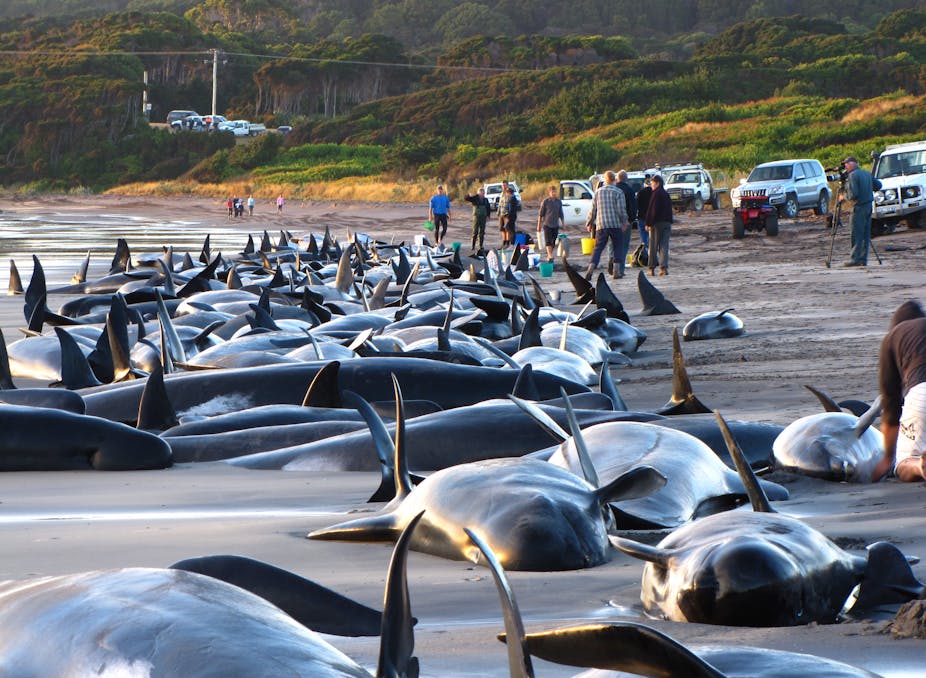Whales are a highly specialised group of mammals which left their terrestrial ancestors for the ocean about 50 million years ago. They have become so well adapted to the marine environment that they can no longer survive for long if they find themselves stranded on a beach.
By and large, they are able to avoid getting themselves in that situation but sometimes, like last weekend on the west coast of Tasmania, something goes wrong and they become stranded. These events are thankfully quite rare, but they inevitably generate considerable interest.
The first question everyone asks is why have the animals stranded in the first place? As is so often the case in biology, there is no simple answer.
In recent years some strandings overseas have been linked to the operation of high intensity sonar. However, the cases where this link has been unambiguously established are relatively few, and have involved a group of whales known as beaked whales, which are deep-diving species seemingly susceptible to sonar. These types of human activities have never been linked to a stranding in Australia.
There are probably as many underlying causes as there are actual strandings. However, by patiently compiling data from each new stranding we are able to tease out some common threads.
For example, we know that some beaches have far more strandings than would be expected if they were completely chance events. The beach at Strahan on the west coast of Tasmania is a good example of a stranding “hot-spot”, with several mass strandings there in the last decade.
In these cases, it is likely that the beach morphology, or shape, plays an important role. Offshore sand banks can create a gutter parallel to the beach. Whales that have moved into shallow water, perhaps in pursuit of prey, can become stuck as the tides recede.

There is also a temporal pattern in the occurrence of strandings: some years having many more strandings than others. The first recorded stranding in Australia was in Victoria in 1825. There is a distinct increasing trend in events since that time, but this is almost certainly a result of in the spread of the population around the coast and the increasing time that Australians have been spending on beaches, rather than a reflection of an increasing number of actual strandings.
Nonetheless, after taking this into account there is still a clear 10-12 year cycle in the number of animals stranding. This is related to a climate feature known as the zonal (westerly) and meridional (southerly) winds.
Persistent zonal and meridional winds result in colder, nutrient-rich waters being driven from the sub-Antarctic to southern Australia, resulting in increased biological activity in the water column during the spring months. This has the effect of attracting whales closer to shore than in other years, making them more vulnerable (but obviously not causing them) to strand.
At any mass stranding, the immediate focus of the local wildlife authorities is understandably the rescue and release of any surviving whales. This is an extraordinarily difficult task: the animals can weigh over 40 tonnes, be partially buried in sand and be lying in a vigorously active surf zone.
In recent years the Tasmanian wildlife authorities (perhaps by virtue of the fact that Tasmania has more mass-strandings than any other state in Australia) have developed techniques that have seen then them successfully re-float and release a number of sperm whales and pilot whales that would certainly have otherwise died.
The fate of these animals remains an important but unanswered question however. There is the possibility that the animals have suffered internal injuries from lying on the beach, or that the disruption of the strong social bonds may be a problem for the inevitably small number of animals that survive.
The only way to really answer this question is to follow the animals in the days and weeks following their rescue. While this is impractical, satellite tags attached to released whales could provide the same information. This has been done on a small scale with released pilot whales in Tasmania, but widespread implementation is dogged by practical difficulties.
For now rescuers must be content with the knowledge that the animals have not re-stranded in the area as the only indicator of their fate.

